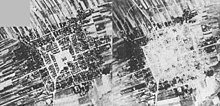Frampol
This article needs additional citations for verification. (August 2022) |
Frampol | ||
|---|---|---|
 Town square | ||
|
Car plates LBL | | |
| Website | http://www.frampol.pl | |
 | ||
Frampol
History
The town was founded in 1717 by Count Marek Antoni Butler, with a unique, highly symmetric layout of streets in the shape of concentric rectangles around a large central square. Its name, originally spelled Franopole, comes from Franciszka née Szczuka, the wife of Count Butler. In 1735, the Jewish community of Frampol already had its own cemetery, and in 1740, Józef Butler funded a wooden church, which since 1778 exists as a separate parish. In the second half of the 18th century, the town belonged to the Wisłocki family. It was an important center of artisans, mostly cloth makers, and like in other locations of eastern Poland, all houses were made of timber. Until 1795, Frampol belonged to Lublin Voivodeship, one of three regions of Lesser Poland. In 1795–1807 it was part of the Habsburg Empire, then it briefly belonged to the Duchy of Warsaw, which in 1815 was turned into Russian-controlled Congress Poland. In 1921, already in the Second Polish Republic, the population of Frampol was 2,720.
During World War II, 90% of the town's buildings were
Currently, it is one of the smallest towns in Poland. In 1869 Frampol lost its official status as a town, to recover it only in 1993.
See also

References
- ^ a b "Local Data Bank". Statistics Poland. Retrieved 2022-08-03. Data for territorial unit 0602054.
External links
- Official town website
- Description of Frampol in the Encyclopedia of Jewish Communities in Poland
- Description of the Jewish Cemetery in Frampol

